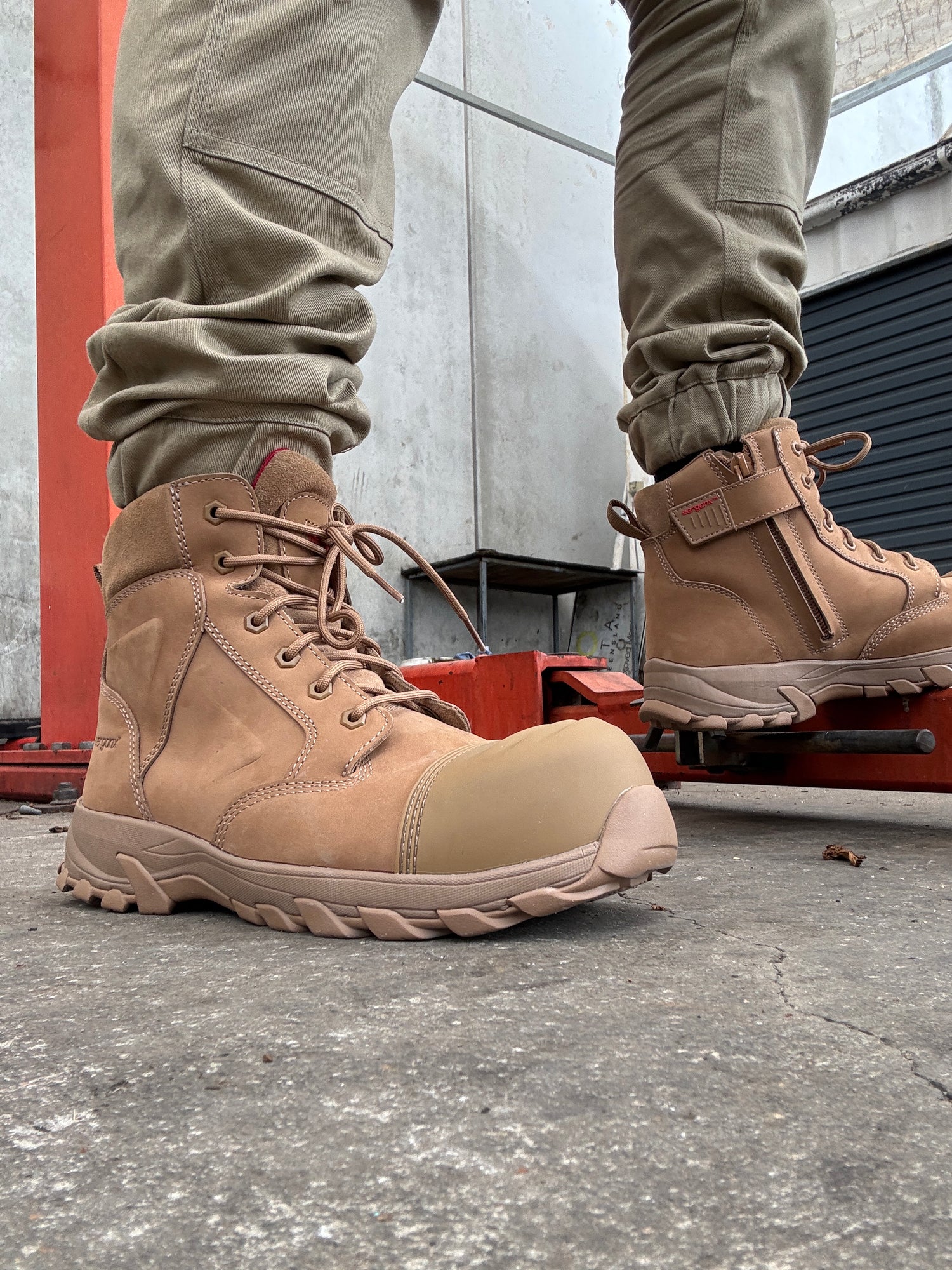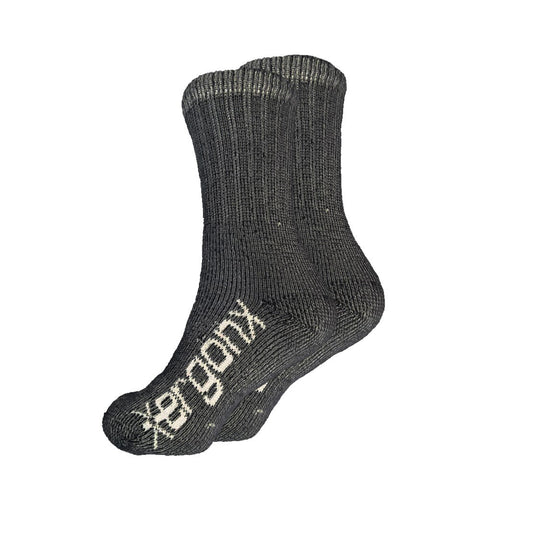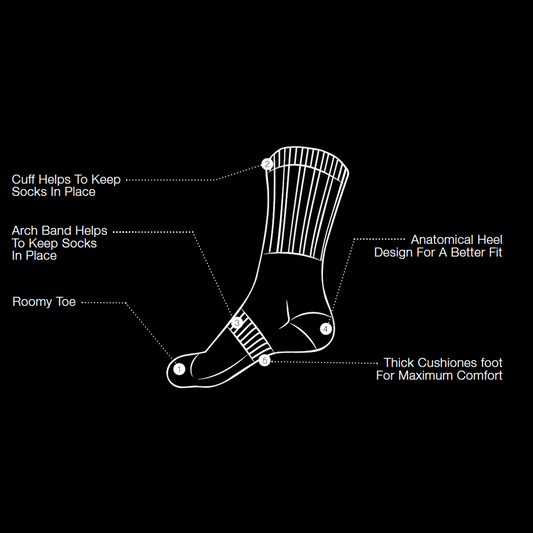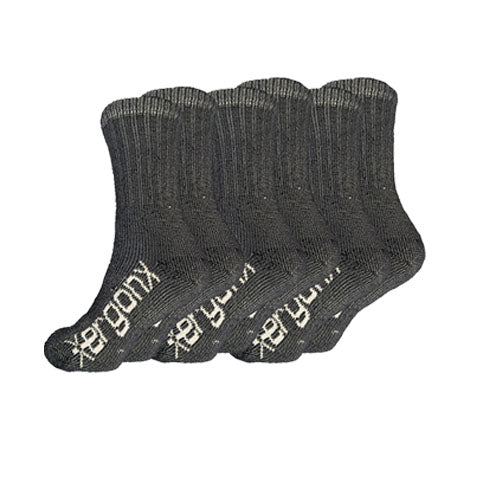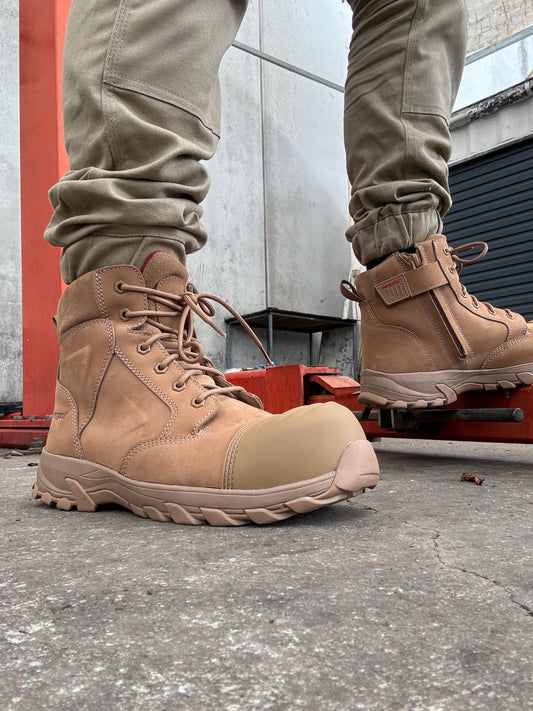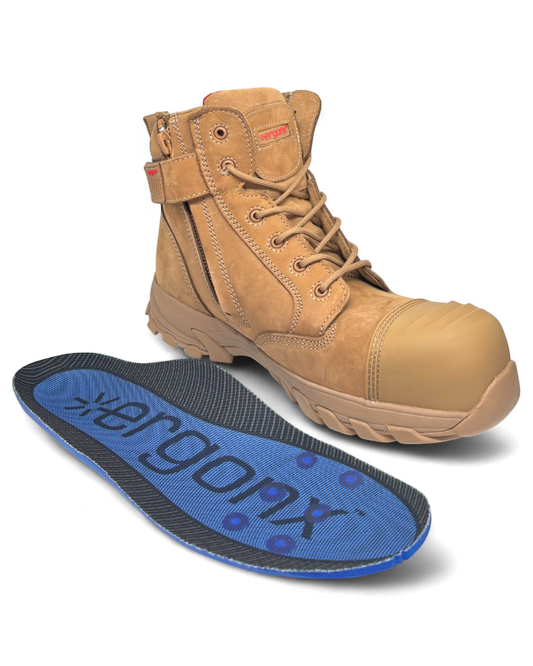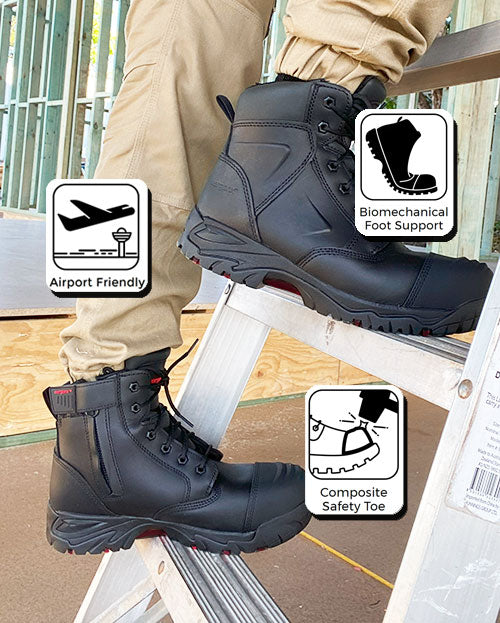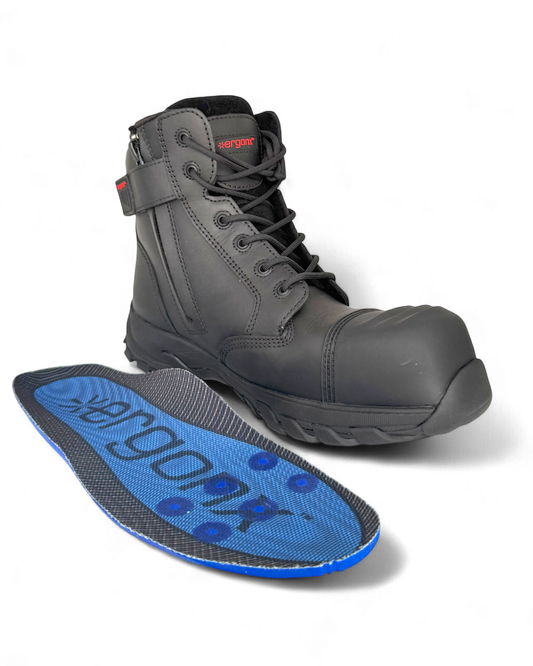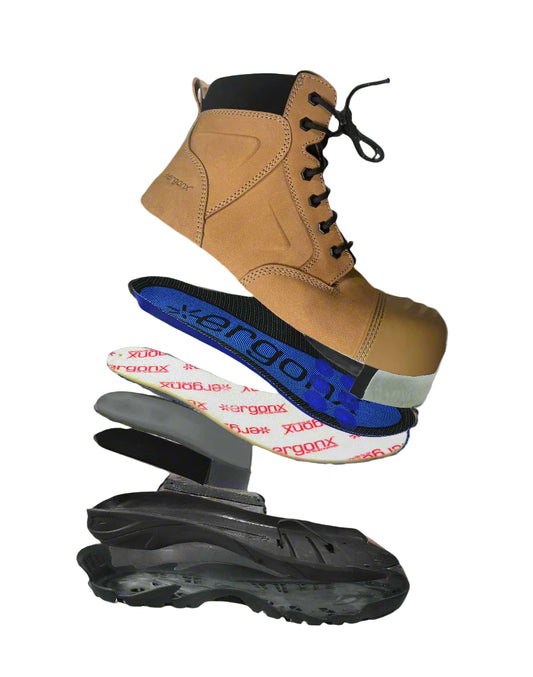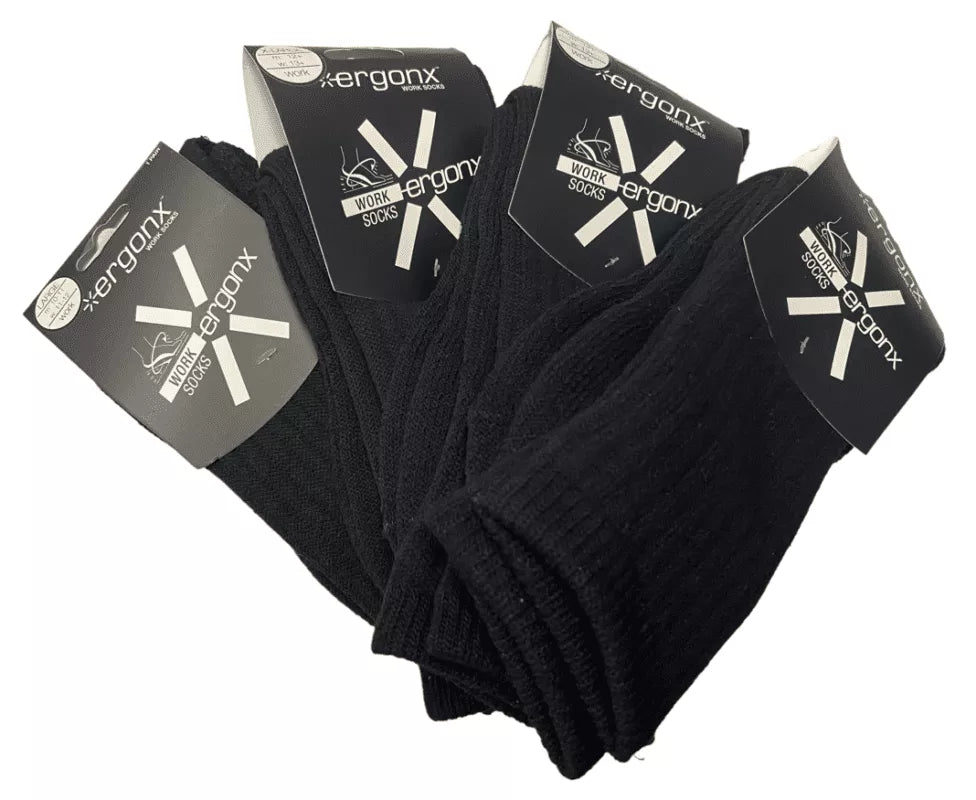Our socks for work boots are especially designed to ensure they stay up high enough that your boots don't rub on your legs and cause irritation. Learn more below.
Shop work boot socks - 25% off 6 packs + free delivery over $79
-
Ergonx Work Socks (1 Pair)
Regular price $29.95 AUDSale price $29.95 AUDUnit price per -
Ergonx Work Socks (6 Pack)
Regular price $134.75 AUDRegular priceUnit price per$179.70 AUDSale price $134.75 AUDSale
HOW TO CHOOSE THE BEST WORK BOOT SOCKS - ACCORDING TO AN AUSTRALIAN PODIATRIST
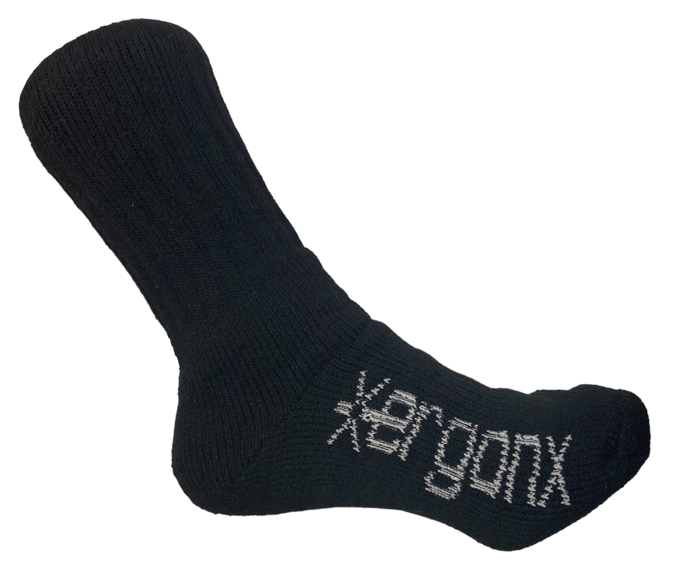
We often get workers through the podiatry clinic with foot issues from painful heels, blisters, and fungal and bacterial infections of the feet. Some of these conditions can stem from and be prevented by selecting the best work socks for their work steel-toe boots. Below is what we look for from a podiatry perspective on how to choose the best socks for your feet during the workday.
HOW DO YOU KEEP SOCKS DRY IN SAFETY BOOTS?
Keeping socks dry in safety boots is essential for maintaining good foot hygiene and preventing foot problems such as blisters and fungal infections.
1. Choose the right socks:
The type of socks you wear can make a big difference in keeping your feet dry. Look for socks made from moisture-wicking materials such as merino wool or synthetic fibres like acrylic. These materials are designed to pull moisture away from the skin and keep your feet dry. Marino wool socks are an excellent option as they are also naturally odour-resistant and antibacterial. Additionally, a silver lining in socks can help reduce bacterial growth and odours.
2. Change your socks daily:
No matter what the manufacturers say, it is important to change your socks every day. Wearing the same socks day after day can lead to an accumulation of moisture and bacteria, increasing the risk of foot problems particularly if you wear thicker wool work socks. By changing your socks daily, you can help to prevent these issues and maintain good foot hygiene.
3. Properly ventilate your work socks and steel toe boots:
Proper ventilation is essential for keeping your feet dry in safety boots. Make sure your work boots are breathable and have adequate ventilation to allow air to circulate around your feet. If your boots are not breathable, consider wearing moisture-wicking socks or using foot powder to help reduce moisture.
Keeping your socks dry in safety boots is essential for maintaining good foot hygiene and preventing foot problems. By choosing the right socks, changing them daily, using foot powder, and properly ventilating your boots, you can help to keep your feet dry and comfortable throughout the day.
MOISTURE MANAGEMENT
A blend of natural and synthetic fibres is preferred over bamboo work socks and cotton socks for your work boots. Thick bamboo work socks can be a reservoir for sweat and can cause blisters and bacterial growth.
Merino wool is a natural fibre that has excellent moisture-wicking properties, making it an ideal material for work socks worn with work boots. When used in work socks, merino wool helps to manage moisture by absorbing sweat and transferring it away from the skin, which can help to keep feet dry and comfortable throughout the day.
Merino wool has a unique structure that allows it to absorb moisture without feeling wet or uncomfortable. The fibres are naturally crimped, which creates small pockets of air that help to regulate temperature and moisture. This means that merino wool can absorb up to 30% of its weight in moisture without feeling damp, making it a highly effective material for managing moisture in work socks. This will help to avoid sweaty feet.
In addition to its moisture-wicking properties, merino wool is also naturally antibacterial and odor-resistant. Sweaty feet will encourage bacterial growth. Marino wool will help to prevent the growth of bacteria that can cause unpleasant odors in work boots. Work socks made with merino wool can help to keep feet fresh and clean even after long hours of use.
Merino wool is also highly durable, making it an ideal material for work socks worn with boots. Its natural elasticity helps to maintain its shape over time, even with repeated use and washing. This means that merino wool work socks can provide long-lasting comfort and moisture management for workers who spend long hours on their feet.
Merino wool is an excellent material for work socks worn with safety boots as it helps to manage moisture, prevent bacterial growth, and provide long-lasting comfort. Its unique structure and natural properties make it an ideal choice for workers who need reliable moisture management and odour control in their footwear.
TEMPERATURE REGULATION
Merino wool is a natural fiber that is well-known for its ability to regulate temperature, making it an ideal material for socks worn with steel capped or composite toe boots. When used in socks, merino wool can help to keep feet warm in cold temperatures and cool in hot temperatures, making it a versatile material that can be worn year-round.
The unique structure of merino wool fibers allows them to regulate temperature by trapping air between the fibers. This trapped air acts as an insulator, helping to keep feet warm in cold temperatures. However, when the temperature rises, the fibers can wick away moisture and release heat, helping to keep feet cool and dry.
In addition to its insulating and moisture-wicking properties, merino wool is also naturally breathable. This means that air can circulate around the foot, helping to regulate temperature and prevent overheating. This can be particularly beneficial for workers who spend long hours on their feet, as it can help to prevent discomfort and fatigue.
Merino wool is also naturally odor-resistant, which can be important for workers who wear steel capped boots for extended periods. By preventing the growth of bacteria that can cause odors, merino wool socks can help to keep feet fresh and clean throughout the day.
CUSHIONING / PADDING
Cushioning and padding are important features in work socks that are worn with steel toe boots for several reasons.
Cushioning and padding can help to prevent pressure pain and injury by reducing the impact of each step. When you walk or stand for extended periods, the repeated impact of your feet against the ground can cause discomfort, foot fatigue, and even lead to injuries such as blisters, calluses, or plantar fasciitis. Thick, cushioned socks with extra padding can help to absorb some of this impact and reduce the pressure on your feet, making it more comfortable to stand and walk.
Cushioning and padding can help to adjust the socks fit of the work boot. A work boot that is too loose can cause your foot to move around inside the boot, leading to blisters and other injuries. Socks can help to fill in the extra space and provide a snugger fit, reducing the risk of injury and improving overall comfort.
Cushioning and padding can help to keep your feet warm in colder temperatures. The extra layers of material in the sock can provide additional insulation to keep your feet warm in the cold and cool in the warm air. This is particularly important for workers who spend long hours outside.
Finally, cushioning and padding can help to improve overall comfort and reduce fatigue. When you wear comfortable, supportive socks, it can make it easier to stand and walk for long periods, reducing the risk of foot fatigue and making it easier to stay focused on the task at hand.
ROOMY TOE
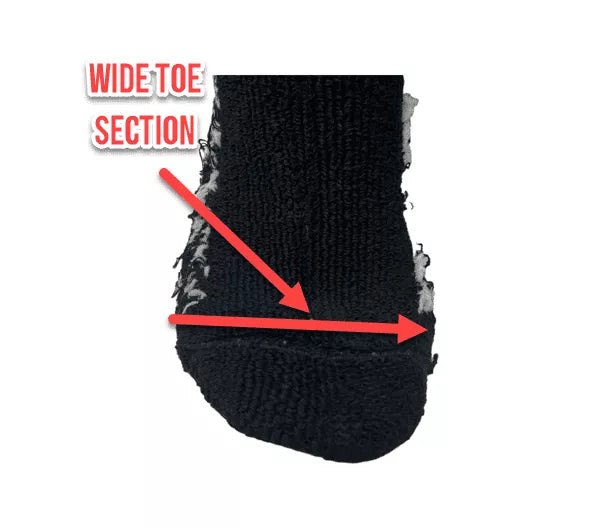
Wearing work socks with a roomy toe area can provide great comfort on the worksite. With enough space in the toe area, your feet won’t be constricted, allowing them to move and flex comfortably. This will be especially important if your job requires standing for extended periods of time, as it can reduce the strain on your feet and lower limbs. Additionally, with enough room, your feet won’t feel cramped, preventing any discomfort that could arise from a lack of circulation.
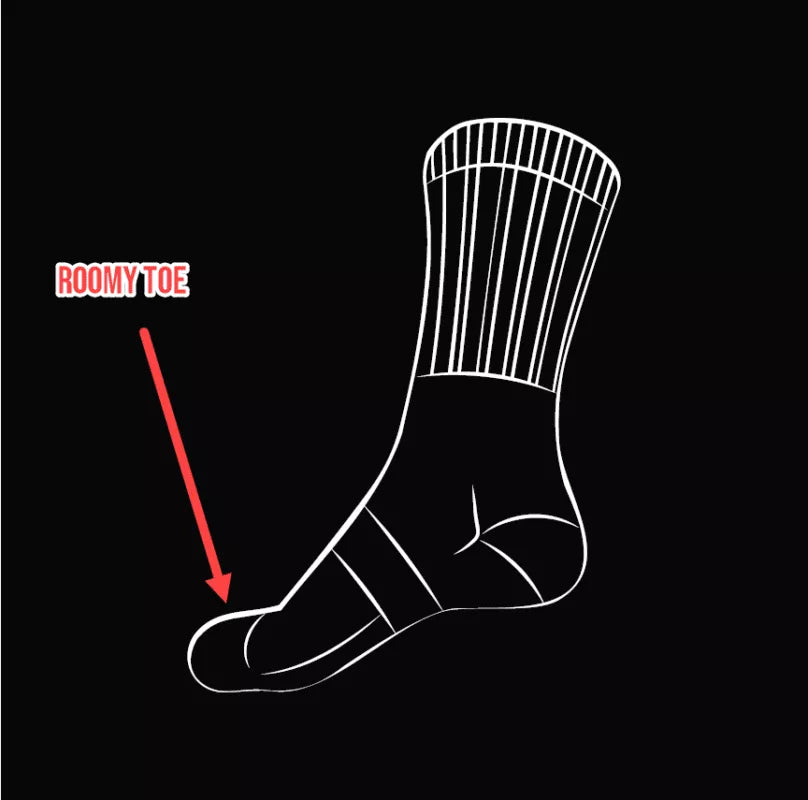
Another benefit of wearing work socks with a roomy toe area is that they allow for expansion as your feet swell throughout the day. This is a common problem for many people who spend long hours on their feet, especially in hot and humid conditions. Tight socks can restrict blood vessels and nerves, leading to discomfort and even pain. But with a roomy toe area, your feet will have the space they need to expand, which can help prevent any constriction that could cause numbness or tingling.
Lastly, work socks with a roomy toe area can help to limit forefoot pains and numbness from Morton’s neuroma, which is a common condition that causes nerve compression in the ball of the foot. Tight socks can exacerbate this condition, as they put pressure on the nerves in the forefoot. But with enough room in the toe area, your feet will have the space they need to avoid any unnecessary pressure. This can help prevent any pain or numbness, making your workday more comfortable and enjoyable.
CUFF TO HOLD THE SOCK IN PLACE
A cuff in a work sock is a band of material that sits at the top of the sock, just above the ankle. The purpose of a cuff in a work sock for steel-toe work boots is to hold the sock up and prevent it from slipping down into the boot during movement.
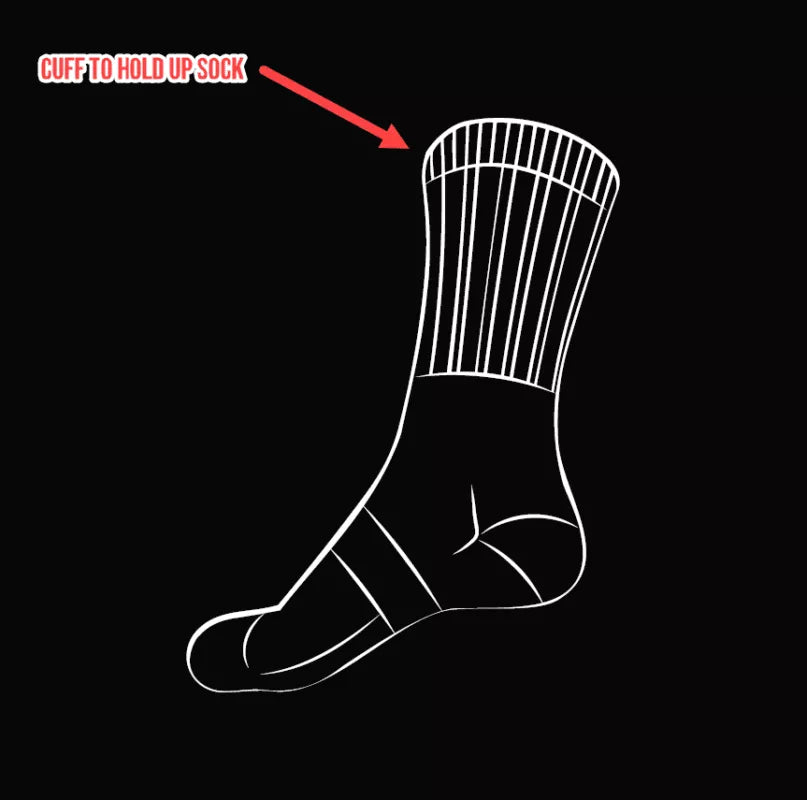
A cuff in a work sock is particularly important for those who wear steel-toe work boots because these boots are typically heavy and can cause socks to slip down or bunch up. This can be both uncomfortable and dangerous, as a sock that slips down can create pressure points, lead to blisters or hot spots, and reduce the overall level of foot protection provided by the work boot.
By holding the sock up, a cuff can help to maintain a proper fit and prevent discomfort and injury. It can also help to keep the foot and ankle area covered and protected, reducing the risk of exposure to the elements, debris, and other hazards that can cause foot injuries.
THICK CUSHIONED FOOT AND HEEL FOR MAXIMUM COMFORT
Wearing thicker socks with extra cushioning in the heel and forefoot in a work sock can provide several benefits for wearers of steel-toed work boots.
Thicker socks with a cushioned reinforced heel and forefoot can help to absorb shock and reduce the impact of each step. Steel-toed work boots can be heavy and place a lot of stress on the feet and lower legs, and a cushioned sock can help to reduce this impact and prevent fatigue and soreness.
A thick cushioned heel and forefoot can help to reduce pressure points and hot spots that can cause discomfort and lead to blisters or other foot injuries. The reinforced heel and forefoot are areas that can experience a lot of friction and pressure, particularly when wearing heavy work boots. A cushioned sock can help to distribute this pressure more evenly, reducing the risk of injury and promoting overall foot comfort.

A thick cushioned heel and forefoot can help to improve insulation and regulate temperature. When working in cold environments, a cushioned sock can help to provide additional insulation to the feet, keeping them warm and comfortable. Additionally, a cushioned sock can help to regulate temperature by wicking away sweat and preventing the feet from becoming too hot and sweaty.
FIT / TIGHTNESS
The fit of a sock is a crucial aspect of the overall comfort of a work sock designed for work boots. Wearing a poorly fitted work sock can be as damaging to your feet as wearing a boot that is the wrong size. Correctly fitted sock will;
1. Keep the sock in place:
A sock that fits well will stay in place and not slide around inside the boot. This can help to prevent blisters, which can be caused by friction from a sock that is sliding around.
2. Helps to limit swelling:
A sock that is too tight can constrict blood flow and cause swelling in the foot. Conversely, a sock that is too loose can allow excess fluid to accumulate in the foot, leading to swelling. A well-fitted sock can help to limit swelling without constricting circulation.
3. Prevents pressure issues and pain:
A sock that is too tight can cause pressure issues and pain, including conditions like Morton’s neuroma. A sock that is too loose can also cause pain and discomfort by allowing the foot to move around inside the boot. A sock that fits well can help to prevent these issues by providing a snug but comfortable fit.
4. Avoids foot injuries:
Tight socks can be just as damaging to the foot as a shoe that is too small. A sock that is too tight can cause blisters, corns, calluses, and other foot problems. On the other hand, socks that are too loose can slip and bunch, causing blisters and pressure lesions on the feet.
CUFF HEIGHT / LEG HEIGHT

The ideal cuff height for a work sock that provides both protection and thermal regulation depends on the specific needs of the wearer.
For optimal protection around the ankle, a higher cuff height is recommended when compared to ankle socks. This will provide a greater barrier between the skin and potential hazards such as debris or sharp objects. We suggest that crew socks are the ideal length for work socks.
Ultimately, the ideal cuff height will vary depending on individual preferences and the specific demands of the work environment. It may be helpful to try different sock styles and heights to find the best option for your needs.
ARCH COMPRESSION BAND
The arch compression band is a great feature in a work sock for several reasons, particularly when worn with steel toe work boots. The arch compression band helps to keep the sock in place, which prevents it from slipping down or bunching up in the boot. This is especially important in work environments where foot protection and stability are crucial, as a poorly fitted sock can compromise both.
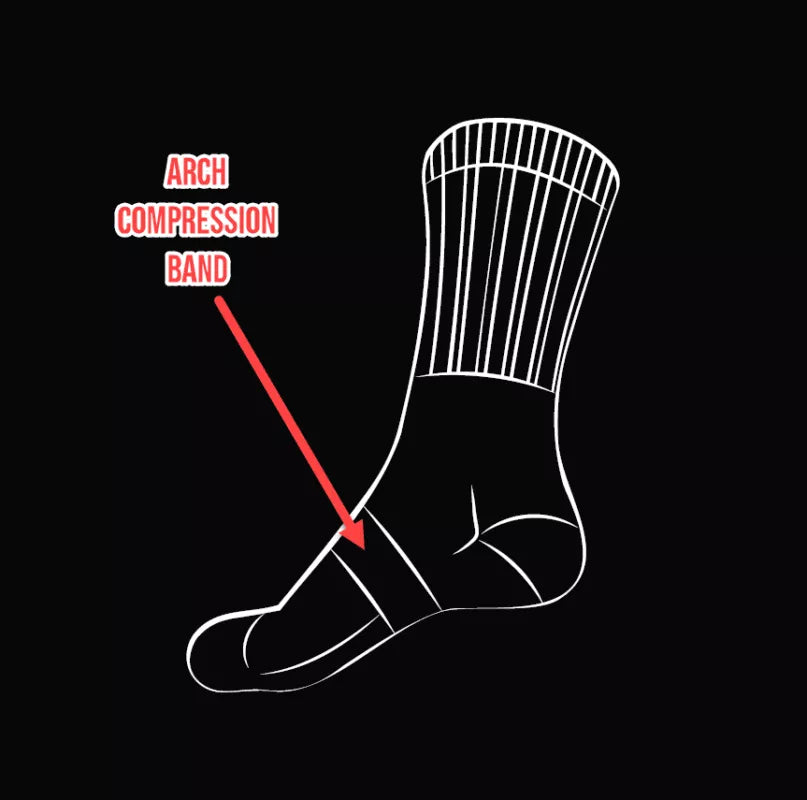
The compression band helps to improve overall comfort by providing targeted support to the arch of the foot. This can help to alleviate fatigue and soreness in the feet, which is especially important for workers who spend long hours on their feet.
Additionally, the arch compression band can also help to improve circulation by gently compressing the blood vessels in the foot. This can help to reduce swelling and discomfort, particularly in hot or humid work environments.
SILVERMESH
Our work socks contain silvermesh yarn that helps to prevent bacterial growth in work socks due to its antimicrobial properties. Silver ions are incorporated into the yarn during the manufacturing process, and these ions work by penetrating the cell walls of bacteria and disrupting their metabolic processes.
Bacteria thrive in warm and moist environments, such as those found inside shoes and socks. When silver yarn is used in work socks and other moisture wicking materials (marino wool), it helps to regulate temperature and moisture by wicking away sweat and reducing the risk of bacterial growth. This makes it more difficult for bacteria to thrive, limiting their growth and preventing the unpleasant odour associated with bacterial growth.

In addition to its antibacterial properties, silver yarn is also effective in preventing the growth of fungi, which can cause conditions such as athlete’s foot. By inhibiting the growth of bacteria and fungi, silver yarn helps to promote better foot hygiene and overall foot health.
ANATOMICAL DESIGN
The anatomical design of a work sock that is specifically designed for use with steel toe work boots can provide several benefits, including increased comfort.
One key anatomical feature is the Y-shaped heel, which is designed to fit the actual shape of the heel. This helps to reduce bunching and slipping of the sock in the boot, which can lead to discomfort and blisters. Additionally, the Y-shaped heel provides a more secure fit, which can help to prevent the sock from sliding down into the boot.
Another important feature is the wider toe area. Steel toe work boots can be tight and constricting, and a sock with a wider toe area can help to alleviate pressure and prevent irritation or rubbing. This can help to reduce discomfort and prevent blisters or other foot injuries.
The stretch forefoot and toe area is also an important anatomical feature. It allows for the feet to change size throughout the day, which is common due to factors such as temperature and activity level. The stretch allows for a more custom fit, which can improve comfort and reduce the risk of foot injuries.
CARING FOR YOUR SOCKS
Caring for your work boot socks made from merino wool, acrylic, and silver yarn is essential for maintaining their quality and effectiveness. Proper care ensures that the socks continue to provide comfort, protection, and durability for an extended period. Here are some reasons why it is important to care for your socks correctly:
- Maintain Quality: Socks made from merino wool, acrylic, and silver yarn are designed to withstand harsh conditions and provide maximum comfort. Proper care ensures that the socks maintain their quality and do not lose their shape or stretchiness, which can affect their effectiveness in protecting your feet.
- Hygiene: Work boot socks are often worn for long hours in hot and humid environments, making them susceptible to odors and bacteria. Proper care, including machine washing, helps to eliminate bacteria, odors, and sweat, ensuring that your feet remain healthy and comfortable.
- Longevity: Proper care ensures that your work boot socks last longer, which can save you money in the long run. Machine washing and tumble drying on low heat can help to prevent shrinkage and maintain the integrity of the fabric, while avoiding bleaching and fabric softener helps to prevent damage to the fibers.
To care for your work boot socks correctly, follow these guidelines:
- Machine wash your socks on a gentle cycle with cold or warm water.
- Tumble dry on low heat to prevent shrinkage.
- Do not bleach your socks, as this can damage the fibers and reduce the effectiveness of the silver yarn.
- Do not wash with fabric softener, as this can clog the pores of the silver yarn and reduce its antimicrobial properties.

About the Author
Kent Elliot (Podiatrist). B App. Sc. Pod (Hons), B.Sc(HMS). M.A. Pod. A
Kent graduated from the University of Queensland with a Bachelor of Science (majoring in Human Movement Studies) and from Podiatry at The Queensland University of Technology (QUT). During this time Kent took a special interest in exercise and conditioning training, orthotics, and plantar fasciitis. Kent has a personal interest in and has participated in many sports including rugby, athletics, boxing, tennis, and running.
Still Scrolling? Shop our comfort work socks here:
-
Ergonx Work Socks (1 Pair)
Regular price $29.95 AUDSale price $29.95 AUDUnit price per -
Ergonx Work Socks (6 Pack)
Regular price $134.75 AUDRegular priceUnit price per$179.70 AUDSale price $134.75 AUDSale
